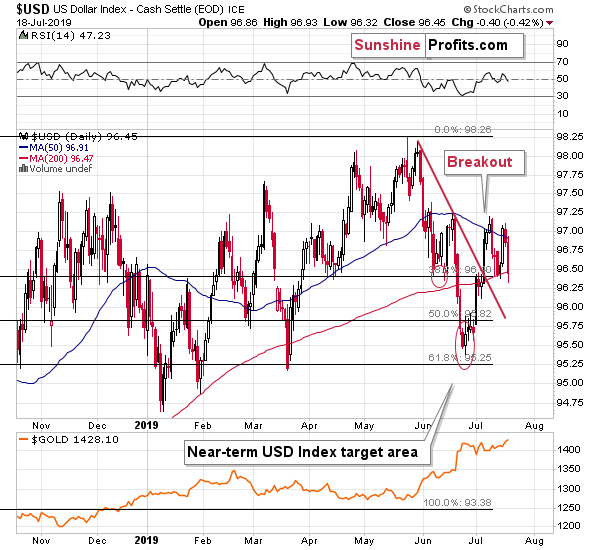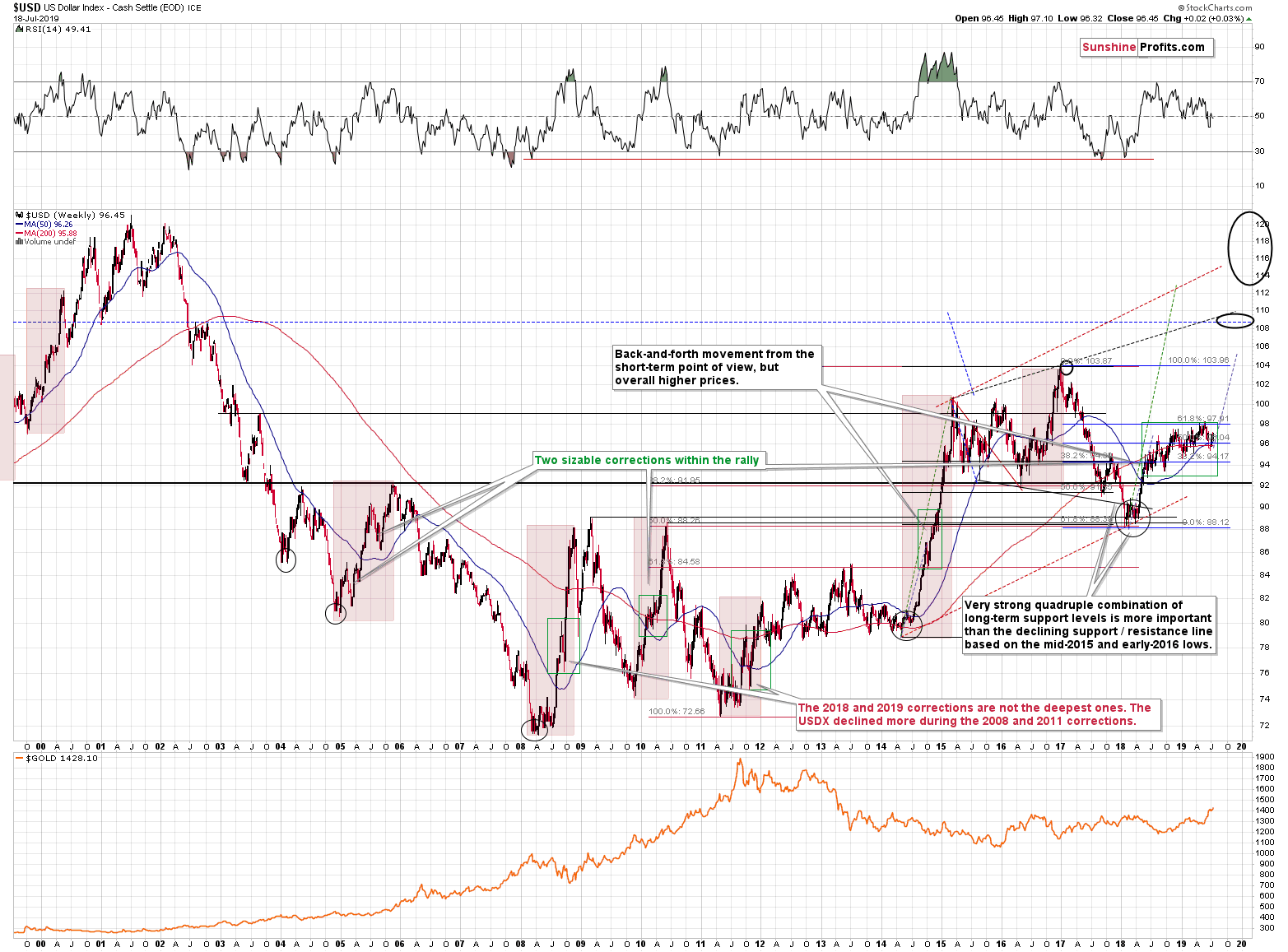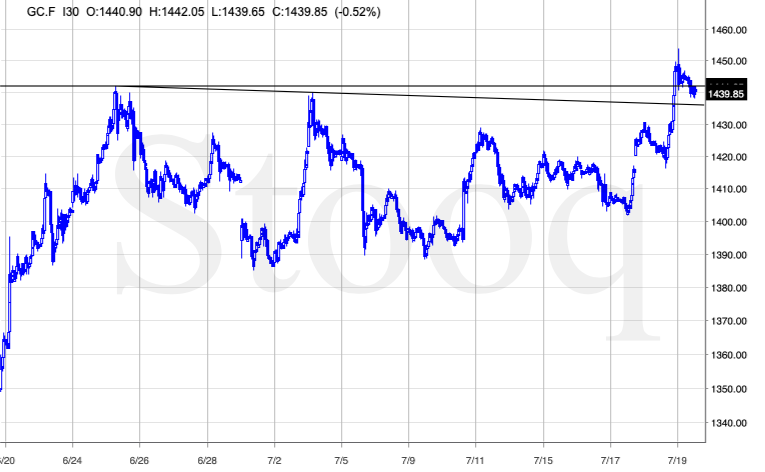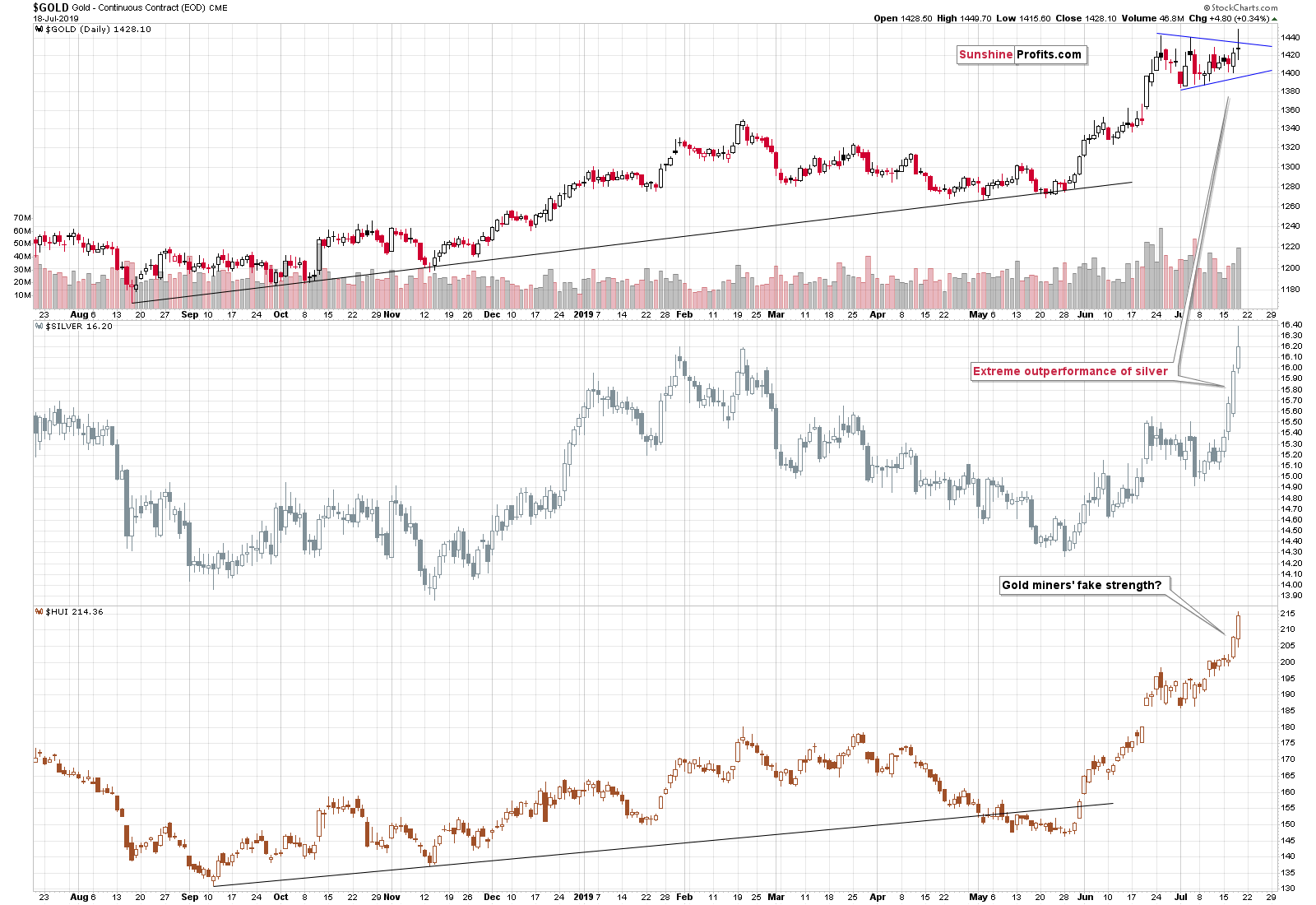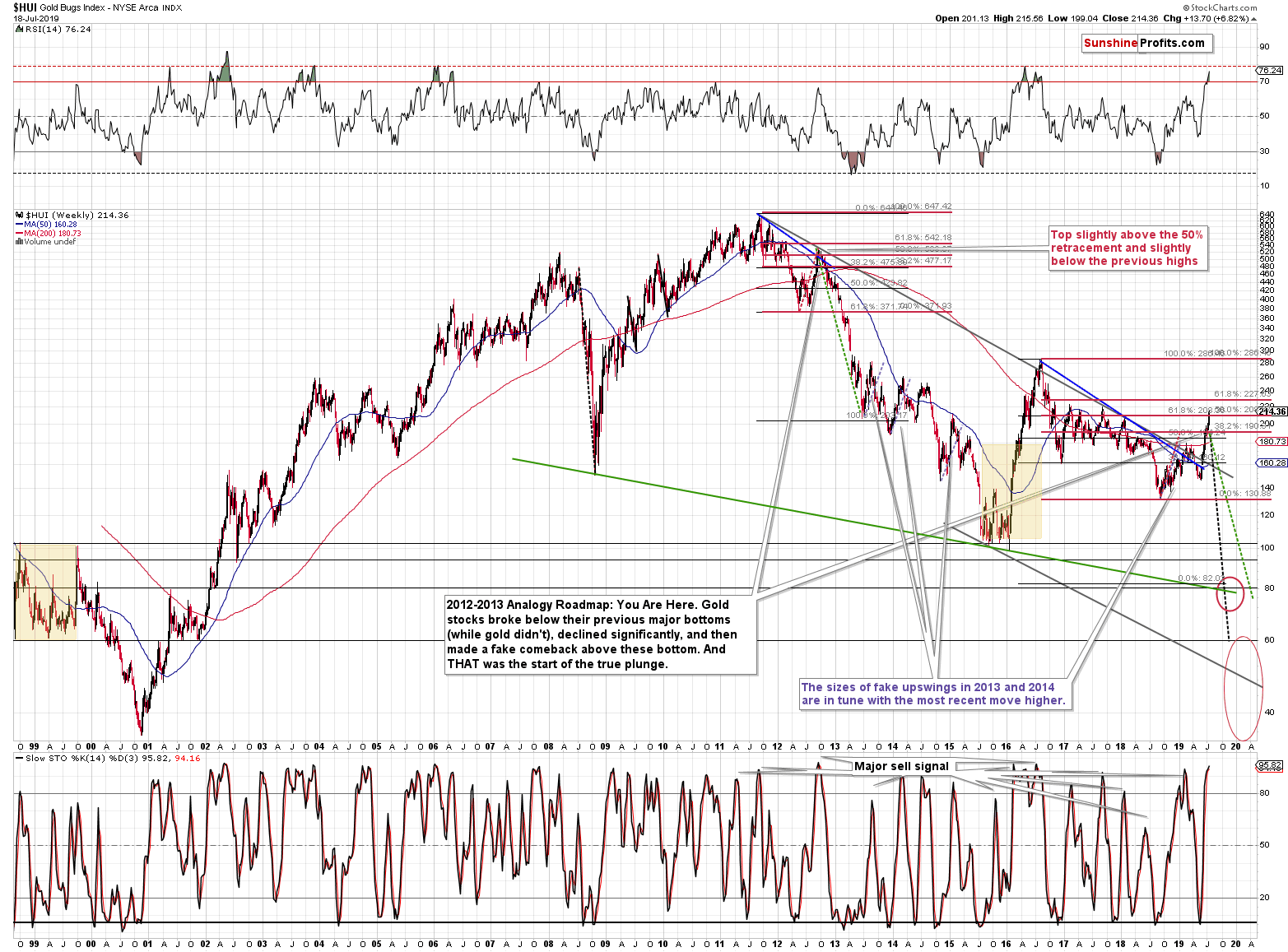Briefly: in our opinion, full (250% of the regular size of the position) speculative short position in silver is justified from the risk/reward perspective at the moment of publishing this Alert. We are moving the stop-loss levels for silver slightly higher. We expect to get back into the short position in gold and mining stocks shortly.
The USD Index moved sharply lower yesterday, and the precious metals market responded with a powerful rally. Once again silver outperformed, and once again mining stock showed strength. What made yesterday's rally different is that gold broke above the previous highs and above the pennant pattern, which suggests even more strength in the following days. How much has really changed with these developments?
Let's start with the USD Index.
USD's Pattern in the Making
The USD chart shows that the inverse head-and-shoulders pattern is developing in a symmetrical manner, which makes the pattern even more believable. Just as we saw two smaller bottoms in the first half of June, we are seeing similar bottoms right now. The USD moved higher today, so the pattern is developing in a rather clear way. If the symmetry continues to be as perfect as it's been recently, what we saw yesterday, was the final bottom before the powerful upswing.
In other words, our yesterday's comments on the above chart remain up-to-date:
The USD Index formed a bullish reversal yesterday, which means that the post-breakout pullback may already be over. If we see higher USD values here - and we are likely to see them - then the USD might soon complete an inverse head and shoulders pattern. The early June bottom would be the left shoulder and the current bottom would be the right shoulder. This pattern - if it is completed - would imply a rally at least as big as the size of the "head" of the pattern starting from the "neck". The head's size is about 1.9, and the neck is at about 97.2, which implies an upside target of at least 99.1. This means a breakout to new 2019 highs.
It would also mean a breakout above the running consolidation and this would imply an upside target of about 105, as the moves that follow consolidations tend to be similar to those that preceded them.
This, in turn, would imply a breakout above the 2016 / 2017 high that could - and likely would - result in an even more profound rally. The next big resistance is at about 108 level. Such a big USD rally is very likely to translate into new lows in gold.
The price of gold and the value of the USD Index don't move in perfect inverse tune at all times, but they move in the opposite directions in general, and big moves in the USDX are very unlikely to be ignored by the yellow metal. And this all might have started with yesterday's reversal.
All right, so if the USD Index just topped, then gold have just topped, right? Most likely yes according to Stockcharts' data, but if we look at the overnight price movement...
Two Views of Gold's Strength
Then we see that gold moved above the pennant pattern and this move has not been invalidated up to this moment. The breakout above the previous high and the consolidation is a bullish factor. While the bearish trend remains intact for the medium-term, this short-term breakout could trigger temporarily higher gold prices in the next 2 weeks or so. At the moment of writing these words, gold invalidated the breakout above the June high, but not above the upper border of the pennant.
All in all, we have a new bullish sign - breakout above the pennant consolidation, and we have a new bearish sign - invalidation of the breakout above the June high. And what about the Stockcharts' view?
Looking at the futures in terms of the closing prices, we see that there was only an attempt to break above the pennant and that it didn't succeed. From this point of view, we saw a big-volume reversal, which has bearish implications. Silver's strength and gold miners' strength simply make our yesterday's comments on the previous days' strength even more up-to-date. Silver's extreme strength became beyond-words extreme and the extraordinary bearish signal became beyond-words bearish.
Let's move to the gold miners next.
The Miners' Lesson from Late 2012
We'll take a look at their strength from the bigger point of view. As a reminder, we didn't move back to the short side of the market with our trading positions in the miners as it was possible that the momentum resulting from the breakout above 200, would carry them even higher temporarily. Here's what we wrote previously:
Yesterday's upswing - although sharp on a day to day basis - remains in tune with the sharp yet temporary upswing of the late 2012. Back in late 2012, the HUI Index moved a bit above its 50% retracement of the preceding decline before the top was formed. The analogous retracement is currently at about 208. Yesterday's high in the HUI Index was 208.07 - very close to the 50% retracement. In 2012, the 50% retracement was temporarily broken before the top formed, so a move even higher here would not change that much in terms of the similarity to the past move.
Why is the situation likely to repeat itself? Because this is what generally tends to happen in the market. Not every time, but often enough to make it worth one's while to look for the similarities. The more similar the moves are, the more likely it is that the follow-up action will be similar as well. Please note that the shape of the 2018 - now rally is also similar to the one that we saw in 2012. The entire rally consisted of two parts that were separated by a decline that started from the 200-week moving average (marked with red). The second rally was sharper and bigger than the initial one. We see the same thing right now. In yesterday's first Alert, we emphasized the similarity with regard to volume in silver - the late-2012 top was one of the cases that were similar to the current situation.
Of course, just as it was the case in late 2012, we now have multiple analysts and investors that are convinced that the entire precious metals market is taking off to new highs. But will this really be the case? We doubt it.
Before looking at the short-term changes, please consider the current breakout above 200 and how similar it is to the early 2016 breakdown below the 100 level. Both numbers are very round and in both cases, gold miners moved to new extremes even though gold didn't. In 2016 the fake breakdown meant the start of the biggest rally in years. With the current strength, are we about to see the biggest decline in years? This appears very likely, also based on silver's outperformance and SLV's epic volume that we discussed yesterday.
The rally is now practically just as big as it was in the late 2012 - naturally in relative terms. The HUI Index is slightly above the 50% Fibonacci retracement, not yet at the 61.8% retracement, and a bit below the previous highs. In this case, these are the 2017 highs, and in the past, these were the early 2012 highs.
Summary
Summing up, these are not pleasant times for anyone who refuses to jump on the bullish bandwagon just because prices are moving higher, but what's profitable is rarely the thing that feels good initially. The relative strength in the silver market is a factor that's beyond bearish, while the strength in gold stocks appears as misleading as their weakness was back in early 2016. Gold moved above the June high, but has already invalidated this move, so the implications here are bearish. The breakout above the pennant in gold is a bullish phenomenon, but it's way too early to pronounce it confirmed. A confirmed breakout above this formation is something that would prevent us from re-entering a short position in gold, even though the medium-term outlook remains bearish. However, the invalidation of the breakout and a close below $1,435 in gold futures, would almost certainly make us short gold once again with the trading capital.
For now, we remain out of the market (with trading capital) in both gold and mining stocks, but we expect to be back on the short side of these market once gold invalidates the breakout above its pennant pattern. We expect to resume our speculative short positions in gold and mining stocks shortly, and will inform you once it becomes justified.
We are moving the stop-loss levels for silver slightly higher.
As always, we'll keep you - our subscribers - informed.
To summarize:
Trading capital (supplementary part of the portfolio; our opinion): Full short position (250% of the full position) in silver is justified from the risk/reward perspective with the following stop-loss orders and exit profit-take price levels:
- Silver: profit-take exit price: $13.81; stop-loss: $16.63; initial target price for the DSLV ETN: $39.38; stop-loss for the DSLV ETN $22.87
We also expect to enter the short positions in gold and mining stocks shortly with the following initial target prices and stop-loss levels:
- Gold: profit-take exit price: $1,241; stop-loss: $1,468; initial target price for the DGLD ETN: $51.87; stop-loss for the DGLD ETN $30.27
- Mining stocks (price levels for the GDX ETF): profit-take exit price: $17.61; stop-loss: $29.27; initial target price for the DUST ETF: $32.28; stop-loss for the DUST ETF $6.88
In case one wants to bet on junior mining stocks' prices (we do not suggest doing so - we think senior mining stocks are more predictable in the case of short-term trades - if one wants to do it anyway, we provide the details), here are the stop-loss details and target prices:
- GDXJ ETF: profit-take exit price: $23.71; stop-loss: $43.47
- JDST ETF: profit-take exit price: $73.32 stop-loss: $13.87
Long-term capital (core part of the portfolio; our opinion): No positions (in other words: cash)
Insurance capital (core part of the portfolio; our opinion): Full position
Whether you already subscribed or not, we encourage you to find out how to make the most of our alerts and read our replies to the most common alert-and-gold-trading-related-questions.
Please note that the in the trading section we describe the situation for the day that the alert is posted. In other words, it we are writing about a speculative position, it means that it is up-to-date on the day it was posted. We are also featuring the initial target prices, so that you can decide whether keeping a position on a given day is something that is in tune with your approach (some moves are too small for medium-term traders and some might appear too big for day-traders).
Plus, you might want to read why our stop-loss orders are usually relatively far from the current price.
Please note that a full position doesn't mean using all of the capital for a given trade. You will find details on our thoughts on gold portfolio structuring in the Key Insights section on our website.
As a reminder - "initial target price" means exactly that - an "initial" one, it's not a price level at which we suggest closing positions. If this becomes the case (like it did in the previous trade) we will refer to these levels as levels of exit orders (exactly as we've done previously). Stop-loss levels, however, are naturally not "initial", but something that, in our opinion, might be entered as an order.
Since it is impossible to synchronize target prices and stop-loss levels for all the ETFs and ETNs with the main markets that we provide these levels for (gold, silver and mining stocks - the GDX ETF), the stop-loss levels and target prices for other ETNs and ETF (among other: UGLD, DGLD, USLV, DSLV, NUGT, DUST, JNUG, JDST) are provided as supplementary, and not as "final". This means that if a stop-loss or a target level is reached for any of the "additional instruments" (DGLD for instance), but not for the "main instrument" (gold in this case), we will view positions in both gold and DGLD as still open and the stop-loss for DGLD would have to be moved lower. On the other hand, if gold moves to a stop-loss level but DGLD doesn't, then we will view both positions (in gold and DGLD) as closed. In other words, since it's not possible to be 100% certain that each related instrument moves to a given level when the underlying instrument does, we can't provide levels that would be binding. The levels that we do provide are our best estimate of the levels that will correspond to the levels in the underlying assets, but it will be the underlying assets that one will need to focus on regarding the signs pointing to closing a given position or keeping it open. We might adjust the levels in the "additional instruments" without adjusting the levels in the "main instruments", which will simply mean that we have improved our estimation of these levels, not that we changed our outlook on the markets. We are already working on a tool that would update these levels on a daily basis for the most popular ETFs, ETNs and individual mining stocks.
Our preferred ways to invest in and to trade gold along with the reasoning can be found in the how to buy gold section. Additionally, our preferred ETFs and ETNs can be found in our Gold & Silver ETF Ranking.
As a reminder, Gold & Silver Trading Alerts are posted before or on each trading day (we usually post them before the opening bell, but we don't promise doing that each day). If there's anything urgent, we will send you an additional small alert before posting the main one.
=====
Latest Free Trading Alerts:
What is the difference between a recession and a depression? When your neighbor loses their job, it's a recession. When you lose your job, that's a depression! Not funny? Do not worry, we won't make more jokes. Instead, we'll analyze a new, but very important and powerful recessionary indicator. We invite you to read our today's article, which discusses the Sahm Unemployment Index, and find out what does it say about the US economy and the gold market.
Sahm Unemployment Index and Gold
=====
Thank you.
Sincerely,
Przemyslaw Radomski, CFA
Editor-in-chief, Gold & Silver Fund Manager


